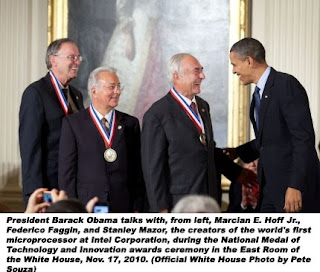President Obama has often spoken of his commitment to “returning science to its rightful place.” Yesterday that place was the East Room of the White House, where the President welcomed the winners of the National Medal of Science and National Medal of Technology and Innovation and presented their awards. Thirteen individuals and a three-person team were recognized for a wide range of groundbreaking achievements that include the development of “super-glue” adhesives, digital photography, and the microprocessors at the heart of today’s computers; insights into human and animal diseases and the biological basis of memory; advances in understanding the dynamics of climate; and profound discoveries in pure mathematics and quantum physics.
The medals, presented by the President in front of an enthusiastic audience of over 200 guests, are the highest honors bestowed by the United States government on scientists, engineers, and inventors. Recipients are selected based on their outstanding contributions to human knowledge and for enhancing American competitiveness and quality of life.
The President praised the laureates for their accomplishments and the profound impact they have had on people’s day-to-day lives. “The scientists and innovators in this room have saved countless lives, improved our health and well-being, unleashed whole new industries and millions of jobs, and transformed the ways we work and learn and communicate,” the President said. “And this incredible contribution serves as proof not only of your own creativity and skill, but of the promise of science itself.”
Many of the awardees honored broke down barriers that had left women and minorities underrepresented in these fields. Semiconductor and materials science pioneer Esther Conwell began her career working as an “assistant engineer,” only to be told that there was no such position for a woman and assigned to serve as an “engineer’s assistant” instead. Still, the President noted, that didn’t stop her from climbing to the highest ranks in her field. Renowned climate modeler Warren Washington became the second African-American to receive the National Medal of Science since its inception in 1959.
The President acknowledged that scientific progress can be difficult and painfully slow. But he also made plain, as he has throughout his tenure in the White House, that science and technology are essential to our ability to address the many challenges facing the Nation today—including boosting the economy, saving energy and the environment, and enhancing national security. “Every day, in research laboratories and on proving grounds, in private labs and university campuses, men and women conduct the difficult, often frustrating work of discovery. It isn’t easy,” he said. “It may take years to prove a hypothesis correct, or decades to learn that it isn’t correct. Often the competition can be fierce, whether in designing a product or securing a grant. And rarely do those who give their all to this pursuit receive the attention or the acclaim they deserve. Yet it is in these labs—often late at night, often fueled by a dangerous combination of coffee and obsession—that our future is being won.”
The ubiquity and utility of some of the discoveries and inventions recognized at the event were underscored when he presented the medal to Steven Sasson, inventor of the digital camera. As Dr. Sasson and the President stood alongside each other, the sound of hundreds of digital camera-clicks filled the room. The resonance of the moment was not lost on the President, who playfully pointed to the bank of photographers.
“This picture better be good,” he quipped.
The East Room ceremony can be viewed here. Also, check out this week’s Tuesday Talk, where three of the award recipients took questions via the Internet.





0 comments:
Post a Comment